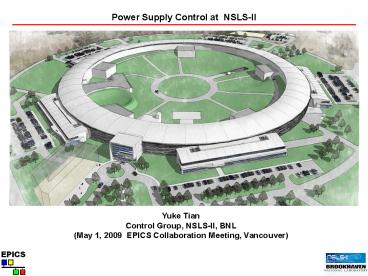Power Supply Control at NSLS-II - PowerPoint PPT Presentation
Title:
Power Supply Control at NSLS-II
Description:
NSLS-II Power Supply Control System: PSC, PSI, Regulator. Power Supply Control System ... Supply Control System: PSI. EPICS Collaboration Meeting, Vancouver ... – PowerPoint PPT presentation
Number of Views:73
Avg rating:3.0/5.0
Title: Power Supply Control at NSLS-II
1
Power Supply Control at NSLS-II
Yuke Tian Control Group, NSLS-II, BNL (May 1,
2009 EPICS Collaboration Meeting, Vancouver)
2
Outline
- Power supply control in accelerator
- 2. NSLS-II power supply control system
- Synchronism, deterministic and reliability in
NSLS-II power supply control - Summary
3
Power supply control in accelerator magnets at
NSLS-II
4
Power supply control in accelerator
Power supply system functions ? Establish
particle orbit ? Orbit correction ?
Beam-based alignment ? Tune adjustment ?
Cure of chromaticity ? Response matrix
measurement ? Power supply analysis Power
supply system performance requirements and
NSLS-II solutions ? Reliability power supply
causes most of the failure time 1) Failures
caused by harsh environments moisture, dust,
temperature etc. 2) Power supply control system
failure communication, IC parts failure etc.
? Synchronization power supply system needs to
be synchronous with other accelerator subsystems
to perform various functions. Usually the
synchronization is done through timing system.
NSLS-II solutions temperature controlled racks.
NSLS-II solutions redundant SDI links Built-in
diagnostic functions.
NSLS-II solutions fully synchronous system
including BPMs, cell controllers and power supply
controllers.
5
Power Supply Control at NSLS-II overview
Events/ / Timing Data
Fast Orbit Feedback Synchronous Bus
Ethernet EPICS Channel Access Protocol
PS control For one cell
CPU
Cell Controller
RFBPM 1
FC1
RFBPM 2
FC2
DCPS 01
FC3
DCPS 02
RFBPM 8
SC1
XRay BPM1
DCPS 39
SC2
XRay BPM2
DC Power Supply Controllers For Multipole Magnets
XRay BPM4
SC6
XRay BPM4
Correctors
6
Power Supply Control at NSLS-II overview
NSLS-II Power Supply Control System
7
NSLS-II Power Supply Control System Cell
Controller
Detailed Structure of Cell Controller
8
NSLS-II Power Supply Control System PSC, PSI,
Regulator
Power Supply Control System
9
NSLS-II Power Supply Control System PSC
Power Supply Controller (PSC)
10
NSLS-II Power Supply Control System PSI
Power Supply Interface (PSI)
11
NSLS-II Power Supply Control System Regulator
Current Regulator Module
12
Synchronism, Deterministic and Reliability in
NSLS-II power supply control
Clock Domains In Accelerators
13
Synchronism, deterministic and reliability in
NSLS-II power supply control
Synchronism in NSLS-II ? 125MHz clock (in
sync with master oscillator) and fiducia will be
distributed. We already have a very fine, low
jitter clock. We can synchronize all circuit
with this RF clock. We can timestamp every event
with 8ns resolution. All the systems are talking
with the same clock. ? Traditional power supply
control system receive a trigger pulse from
timing system and use local oscillators to drive
the DAC, ADC etc.
NSLS-II solutions pushing synchronism to power
supply control. The DAC, ADC and FPGA are
synchronous with RF main oscillator. The local
oscillators are for back up in case the RF main
oscillator is not available.
14
Synchronism, deterministic and reliability in
NSLS-II power supply control
Pushing Synchronism to Power Supply Control at
NSLS-II
15
Synchronism, deterministic and reliability in
NSLS-II power supply control
Latency of Power Supply SDI Link
PS setpoint PS readback PS for fast correctors Total data for FOFB 100Mbit/s SDI link
2 18-bit DAC 8-bit command (7 bytes/PS) 10 16-bit ADC (20bytes) 6 PS Setpoints 7x642 byte Readback 20 byte Assume payload 42 bytes 42 7 294 Byte (2948)/100Mb 24us
16
Summary
At NSLS-II, power supplies and the power
supply control systems are designed with goals of
high reliability, easy for diagnostics, and easy
for integration. At NSLS-II, we are design a
open source communication interface for power
supply control system. It offers more advantages
than other communications interface such as
RS232, RS485, CAN etc. At NSLS-II, we are
pushing synchronism to power supply control
level. So, all the subsystems (BPM, PS, LLRF etc)
are all synchronized, many accelerator
applications can benefit from this
synchronism. ? Fast orbit feedback system
1) Synchronous distribution of BPM data (by SDI
between cells) 2) Matrix math and
regulation (done with the same clock) 3)
Corrector PS actions (by SDI between PS
controller) ? Response matrix measurement
1) Synchronous kick one or more magnets (by SDI
between PS controller) 2) Synchronous
measurement of the BPM data (by GigE
interface) ? Other applications tune
measurements, synchronous PS ramping etc.
17
Acknowledgement Wing Louie (BNL) John
Ricciardelli (BNL) George Ganetis (BNL) Larry
Doolittle (LBNL) Bob Dalesio (BNL) Carlos Serrano
(LBNL) Thank you !































